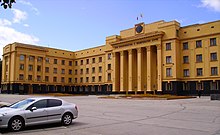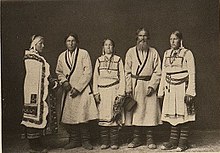
A | B | C | D | E | F | G | H | CH | I | J | K | L | M | N | O | P | Q | R | S | T | U | V | W | X | Y | Z | 0 | 1 | 2 | 3 | 4 | 5 | 6 | 7 | 8 | 9
Chuvash Republic — Chuvashia
| |
|---|---|
| Anthem: Чӑваш Республикин патшалӑх гимнӗ State Anthem of the Chuvash Republic"[2] | |
 | |
| Coordinates: 55°33′N 47°06′E / 55.550°N 47.100°E | |
| Country | Russia |
| Federal district[1] | Volga |
| Economic region[3] | Volga-Vyatka |
| Capital | Cheboksary[4] |
| Government | |
| • Type | State Council[5] |
| • Head[7] | Oleg Nikolayev[6] |
| Area | |
| • Total | 18,343 km2 (7,082 sq mi) |
| Population | |
| • Total | |
| • Rank | 39th |
| • Urban | 63.9% |
| • Rural | 36.1% |
| Time zone | UTC+3 (MSK+2[9]) |
| ISO 3166 code | RU-CU |
| Vehicle registration | 21, 121 |
| Official language(s) | Chuvash[10] • Russian[11] |
| Website | cap.ru |
Chuvashia (Russian: Чувашия; Chuvash: Чӑваш Ен, romanized: Çăvaš Jen), officially the Chuvash Republic — Chuvashia,[note 1] is a republic of Russia located in Eastern Europe. It is the homeland of the Chuvash people, a Turkic ethnic group. Its capital is the city of Cheboksary. As of the 2010 Census, its population was 1,251,619.[12]
Geography
The Chuvash Republic is located in the center of European Russia, in the heart of the Volga-Vyatka economic region, mostly to the west of the Volga River, in the Volga Upland. It borders with the Nizhny Novgorod Oblast in the west, Mari El Republic in the north, the Republic of Tatarstan in the east and southeast, Republic of Mordovia in the southwest, and the Ulyanovsk Oblast in the south. There are over two thousand rivers in the republic—with the major ones being the Volga, the Sura, and the Tsivil—as well as four hundred lakes. Some of the Volga River valley reservoirs are in the north of the republic, and the Sura River flows towards the Volga along much of the republic's western boundary.
The climate is moderately continental, with the average temperatures ranging from −13 °C (9 °F) in January to +19 °C (66 °F) in July. Annual precipitation varies between 450 and 700 millimeters (18 and 28 in), but is uneven from one year to another. Natural resources include gypsum, sand, clay, sapropel deposits, phosphorite, and peat. There are oil and natural gas deposits, although their extraction has not yet been commercially pursued. Forests, mostly in the south along the Sura River, cover approximately 30% of the land.[13]
History

The ancestors of the Chuvash were Bulgars and Suars, Oghur Turkic tribes residing in the Northern Caucasus in the 5th to 8th centuries. In the 7th and 8th centuries, a part of the Bulgars left for the Balkans, where, together with local South Slavs, they established the state of modern Bulgaria. Another part moved to the Middle Volga Region (see Volga Bulgaria), where the Bulgar population that did not adopt Islam formed the foundation of the Chuvash people.[13]
During the Mongol invasion of Volga Bulgaria, the steppe-dwelling Suar migrated north, where Volga Finnic tribes, such as the Mordvins and Mari lived. The Chuvash claim to be the descendants of these Suars who assimilated with the Mari. In 1242, they became vassals of the Golden Horde. Later Mongol and Tatar rulers did not intervene in local internal affairs as long as tribute was paid annually to Sarai. When the power of the Golden Horde began to diminish, local Mişär Tatar Murzas from Piana and Temnikov tried to govern the Chuvash area.
During Ivan the Terrible's war of conquest against the Khanate of Kazan, in August 1552, the Chuvash Orsai and Mari Akpar Tokari princes swore their loyalty to the Grand Duchy of Muscovy at Alatyr on the Sura River. Between 1650 and 1850, the Russian Orthodox Church sent Chuvash-speaking missionaries to try to convert the Chuvash to the Orthodox faith. A group of these missionaries created a written Chuvash language. Most of the Chuvash who stayed in the area became Orthodox Christians, but some remained pagan.
On May 15, 1917, the Chuvash joined the Idel-Ural Movement and in December 1917 joined the short-lived Idel-Ural State, when an agreement was reached with Tatar representatives to draw the eastern border of Chuvashia at the Sviyaga River. In 1918–1919, the Russian Civil War encompassed the area. This ended with victory for the Bolsheviks. To gain support from the local population, Lenin ordered the creation of a Chuvash state within the Russian SFSR. On June 24, 1920, the Chuvash Autonomous Oblast was formed, which was transformed into the Chuvash ASSR in April 1925.
Administrative divisions
Politics


Until 2012, the Chuvash Republic officially had the status of a state. In the constitution of Chuvashia (version 6 - dated September 13, 2011 No. 46), the following was fixed: "The Chuvash Republic is a republic (state) within the Russian Federation."
During the Soviet period, the high authority in the republic was shared between three persons: The first secretary of the Chuvashia CPSU Committee (who in reality had the biggest authority), the chairman of the oblast Soviet (legislative power), and the Chairman of the Republic Executive Committee (executive power). Since 1991, CPSU lost all the power, and the head of the Republic administration, and eventually the governor was appointed/elected alongside elected regional parliament.
The Charter of Republic of Chuvashia is the fundamental law of the region. The State Council of the Chuvash Republic is the republic's regional standing legislative (representative) body. The highest executive body is the Republic's Government, which includes territorial executive bodies such as district administrations, committees, and commissions that facilitate development and run the day to day matters.
Demographics
Despite not being large, the republic is one of the most densely populated regions in the Russian Federation.[citation needed] Population: 1,251,619 (2010 Russian census);[12] 1,313,754 (2002 Census);[14] 1,336,066 (1989 Soviet census).[15]
The capital (and largest city) is Cheboksary (population 464,000 in 2010). Cheboksary is situated mostly on the southern bank of the Volga in the northern part of the republic (one northern bank district was added in the second part of the 20th century), approximately 650 kilometers (400 mi) east of Moscow. Nearby to the east is the next largest city, Novocheboksarsk (population 124,000 in 2010).
Settlements
Largest cities or towns in Chuvashia
2010 Russian Census | |||||||||
|---|---|---|---|---|---|---|---|---|---|
| Rank | Administrative Division | Pop. | |||||||
 Cheboksary  Novocheboksarsk |
1 | Cheboksary | City of republic significance of Cheboksary | 453,721 |  Kanash  Alatyr | ||||
| 2 | Novocheboksarsk | City of republic significance of Novocheboksarsk | 124,097 | ||||||
| 3 | Kanash | Kanashsky District | 45,607 | ||||||
| 4 | Alatyr | Alatyrsky District | 38,203 | ||||||
| 5 | Shumerlya | Shumerlinsky District | 31,722 | ||||||
| 6 | Tsivilsk | Tsivilsky District | 13,479 | ||||||
| 7 | Kugesi | Cheboksarsky District | 11,917 | ||||||
| 8 | Kozlovka | Kozlovsky District | 10,359 | ||||||
| 9 | Vurnary | Vurnarsky District | 10,086 | ||||||
| 10 | Yadrin | Yadrinsky District | 9,614 | ||||||
| Year | Pop. | ±% |
|---|---|---|
| 1926 | 888,960 | — |
| 1959 | 1,097,859 | +23.5% |
| 1970 | 1,223,675 | +11.5% |
| 1979 | 1,292,486 | +5.6% |
| 1989 | 1,336,066 | +3.4% |
| 2002 | 1,313,754 | −1.7% |
| 2010 | 1,251,619 | −4.7% |
| 2021 | 1,186,909 | −5.2% |
| Source: Census data | ||
Vital statistics


- Source: Russian Federal State Statistics Service Archived April 12, 2008, at the Wayback Machine
| Average population (× 1,000) | Live births | Deaths | Natural change | Crude birth rate (per 1,000) | Crude death rate (per 1,000) | Natural change (per 1,000) | Fertility rates | |
|---|---|---|---|---|---|---|---|---|
| 1970 | 1,227 | 22,465 | 10,993 | 11,472 | 18.3 | 9.0 | 9.3 | |
| 1975 | 1,266 | 22,956 | 12,450 | 10,506 | 18.1 | 9.8 | 8.3 | |
| 1980 | 1,302 | 22,612 | 13,908 | 8,704 | 17.4 | 10.7 | 6.7 | |
| 1985 | 1,311 | 24,385 | 13,913 | 10,472 | 18.6 | 10.6 | 8.0 | |
| 1990 | 1,339 | 21,116 | 13,545 | 7,571 | 15.8 | 10.1 | 5.7 | 2.12 |
| 1991 | 1,342 | 19,113 | 13,459 | 5,654 | 14.2 | 10.0 | 4.2 | 1.96 |
| 1992 | 1,346 | 16,673 | 14,141 | 2,532 | 12.4 | 10.5 | 1.9 | 1.72 |
| 1993 | 1,347 | 14,410 | 16,876 | −2,466 | 10.7 | 12.5 | −1.8 | 1.48 |
| 1994 | 1,345 | 14,498 | 18,003 | −3,505 | 10.8 | 13.4 | −2.6 | 1.48 |
| 1995 | 1,345 | 13,842 | 17,727 | −3,885 | 10.3 | 13.2 | −2.9 | 1.41 |
| 1996 | 1,343 | 13,542 | 16,880 | −3,338 | 10.1 | 12.6 | −2.5 | 1.37 |
| 1997 | 1,341 | 12,822 | 16,762 | −3,940 | 9.6 | 12.5 | −2.9 | 1.30 |
| 1998 | 1,339 | 13,300 | 15,957 | −2,657 | 9.9 | 11.9 | −2.0 | 1.34 |
| 1999 | 1,337 | 12,129 | 17,997 | −5,868 | 9.1 | 13.5 | −4.4 | 1.22 |
| 2000 | 1,331 | 12,363 | 18,640 | −6,277 | 9.3 | 14.0 | −4.7 | 1.25 |
| 2001 | 1,324 | 11,986 | 18,980 | −6,994 | 9.1 | 14.3 | −5.3 | 1.20 |
| 2002 | 1,314 | 12,956 | 19,808 | −6,852 | 9.9 | 15.1 | −5.2 | 1.30 |
| 2003 | 1,304 | 13,171 | 19,978 | −6,807 | 10.1 | 15.3 | −5.2 | 1.32 |
| 2004 | 1,295 | 13,734 | 19,371 | −5,637 | 10.6 | 15.0 | −4.4 | 1.38 |
| 2005 | 1,286 | 13,133 | 19,682 | −6,549 | 10.2 | 15.3 | −5.1 | 1.32
Zdroj:https://en.wikipedia.org?pojem=Chuvash_Republic Text je dostupný za podmienok Creative Commons Attribution/Share-Alike License 3.0 Unported; prípadne za ďalších podmienok. Podrobnejšie informácie nájdete na stránke Podmienky použitia.
Analytika
Antropológia Aplikované vedy Bibliometria Dejiny vedy Encyklopédie Filozofia vedy Forenzné vedy Humanitné vedy Knižničná veda Kryogenika Kryptológia Kulturológia Literárna veda Medzidisciplinárne oblasti Metódy kvantitatívnej analýzy Metavedy Metodika Text je dostupný za podmienok Creative
Commons Attribution/Share-Alike License 3.0 Unported; prípadne za ďalších
podmienok. www.astronomia.sk | www.biologia.sk | www.botanika.sk | www.dejiny.sk | www.economy.sk | www.elektrotechnika.sk | www.estetika.sk | www.farmakologia.sk | www.filozofia.sk | Fyzika | www.futurologia.sk | www.genetika.sk | www.chemia.sk | www.lingvistika.sk | www.politologia.sk | www.psychologia.sk | www.sexuologia.sk | www.sociologia.sk | www.veda.sk I www.zoologia.sk |


